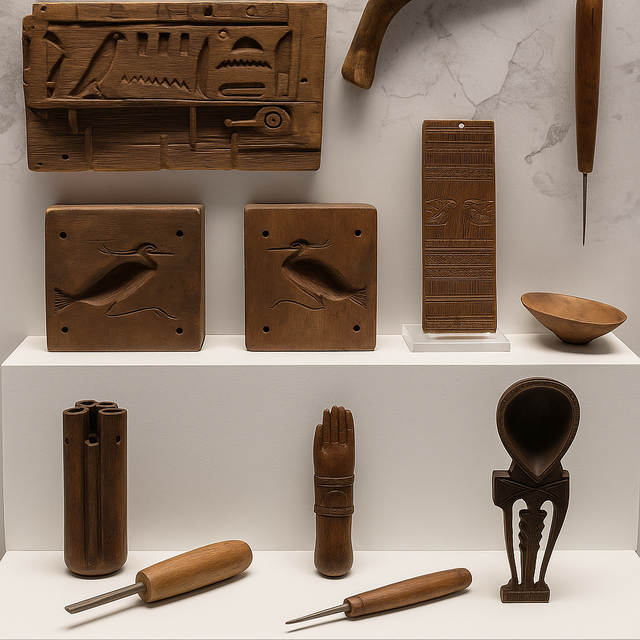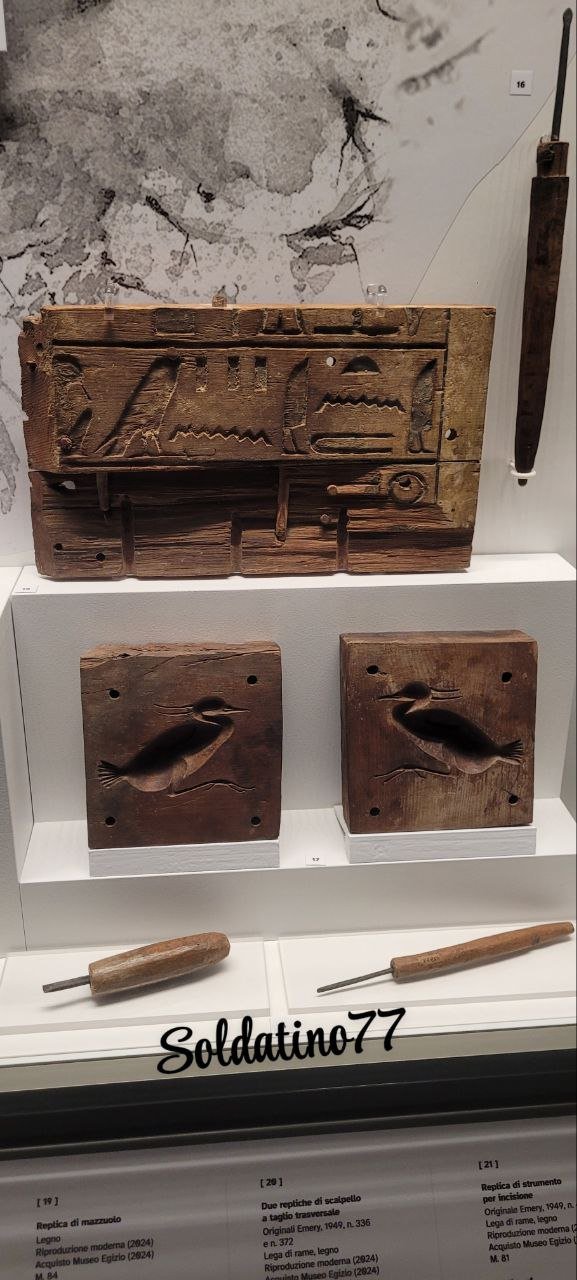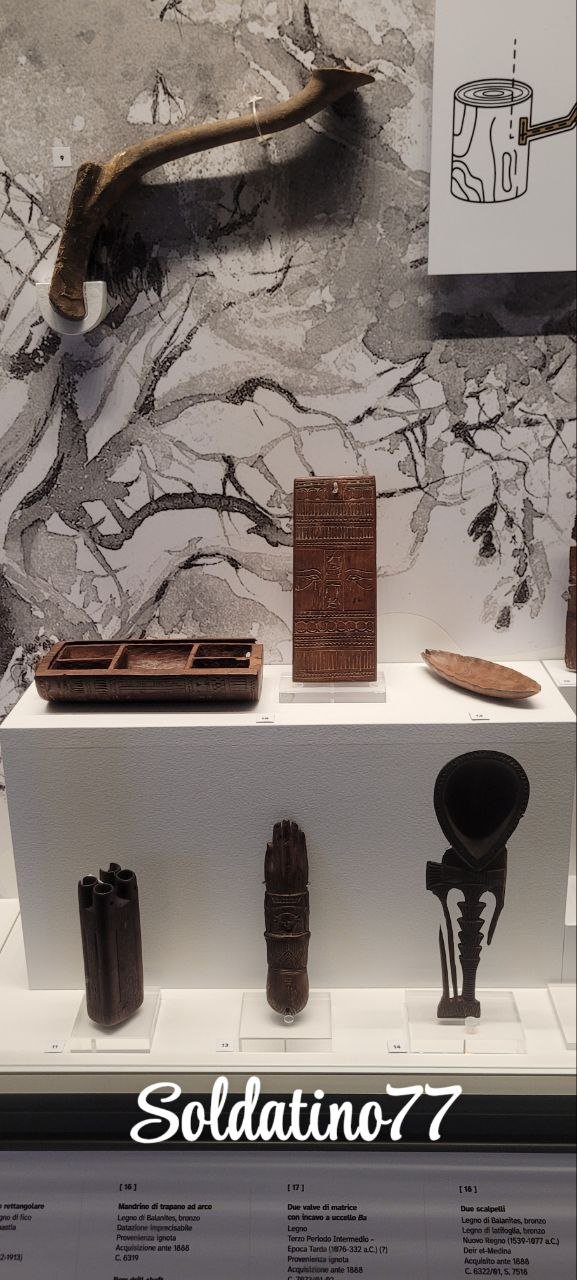Stampi, strumenti e utensili dell’artigianato Egizio 🛠️📜
Queste foto mostrano una serie di utensili lignei, stampi e strumenti utilizzati dagli artigiani egizi per la lavorazione di oggetti in metallo, legno e pietra, risalenti prevalentemente al Medio Regno (circa 2050–1700 a.C.) e al Nuovo Regno (1550–1070 a.C.), ma anche a epoche successive.
- Stampi in legno:
In alto, uno stampo decorato con geroglifici inciso nel legno, probabilmente utilizzato per realizzare decorazioni o amuleti in faience o metallo fuso.
In basso, due stampini con sagoma di uccello (probabilmente un airone o ibis sacro) utilizzati per creare oggetti decorativi o amuleti con forme protettive e simboliche.
- Scalpelli e mazzuoli:
Gli strumenti esposti in basso erano utilizzati per incidere, intagliare e rifinire manufatti lignei e in pietra calcarea, indispensabili per realizzare decorazioni su sarcofagi, statue e arredi.
- Manico di trapano ad arco:
In alto, il manico in legno di un trapano ad arco, strumento utilizzato per forare pietre semipreziose, legno o conchiglie nella realizzazione di gioielli.
- Palette e tavolette per cosmetici:
Gli oggetti rettangolari e ovali erano impiegati per pestare e mescolare pigmenti utilizzati nel trucco (kohl nero, ocra rossa) e nella pittura.
- Stampi e matrici:
Oggetti tubolari e a forma di mano erano utilizzati come matrici per fusione o come stampi per realizzare elementi decorativi in metallo o faience.
- Strumenti per incidere e intagliare:
Gli scalpelli e i punteruoli in legno e bronzo servivano per lavori di dettaglio nella creazione di oggetti rituali o arredi funerari.
Questi strumenti e stampi dimostrano l’abilità degli artigiani egizi, capaci di realizzare amuleti, gioielli, statue e arredi con tecniche precise e ripetibili. Gli stampi con simboli religiosi come l’ibis o decorazioni geroglifiche erano fondamentali per produrre oggetti in serie da inserire nei corredi funerari o da utilizzare nei templi.
Questi oggetti raccontano il connubio tra artigianato e religione nell’antico Egitto, dove ogni simbolo aveva valore protettivo, magico o apotropaico, e ogni strumento era parte di una tradizione tramandata per secoli.
Quale di questi strumenti vi incuriosisce di più? Vi piacerebbe vederne una dimostrazione pratica di utilizzo? Scrivetelo nei commenti e lasciate un like per gli artigiani dell’antico Egitto! 👍🛠️🏺📜
La prima foto l'ho creata con l'intelligenza artificiale mentre le altre le ho scattate personalmente al Museo degli Egizi 📸🕵🏻♂️🏛️
Traduzione in inglese 🇬🇧
These photos show a series of wooden tools, molds, and instruments used by Egyptian craftsmen for working metal, wood, and stone, mostly dating back to the Middle Kingdom (c. 2050–1700 BCE) and the New Kingdom (1550–1070 BCE), but also to later periods.
- Wooden Molds:
At the top, there is a decorated mold with hieroglyphs carved into wood, probably used to create decorations or amulets in faience or molten metal.
Below, two molds featuring the shape of a bird (likely a heron or sacred ibis), used to create decorative objects or amulets with protective and symbolic forms.
- Chisels and Mallets:
The tools displayed below were used for carving, engraving, and finishing wooden and limestone artifacts, essential for creating decorations on sarcophagi, statues, and furniture.
- Bow Drill Handle:
At the top, the wooden handle of a bow drill, a tool used for drilling semi-precious stones, wood, or shells in the making of jewelry.
- Cosmetic Palettes and Tablets:
The rectangular and oval objects were used for grinding and mixing pigments used in makeup (black kohl, red ochre) and in painting.
- Molds and Matrices:
Tubular and hand-shaped objects were used as casting molds or matrices to create decorative elements in metal or faience.
- Engraving and Carving Tools:
The chisels and awls in wood and bronze were used for detailed work in the creation of ritual objects or funerary furnishings.
These tools and molds demonstrate the skill of Egyptian craftsmen, who were able to create amulets, jewelry, statues, and furniture with precise and repeatable techniques. Molds with religious symbols such as the ibis or hieroglyphic decorations were essential for producing series of objects to be placed in funerary assemblages or used in temples.
These objects tell the story of the connection between craftsmanship and religion in Ancient Egypt, where every symbol held protective, magical, or apotropaic value, and every tool was part of a tradition handed down over centuries.
Which of these tools do you find most intriguing? Would you like to see a live demonstration of how they were used? Share your thoughts in the comments and leave a like for the craftsmen of Ancient Egypt! 👍🛠️🏺📜
The first photo was created with artificial intelligence, while the others were personally taken by me at the Egyptian Museum 📸🕵🏻♂️🏛️



Hi. How about claiming your rewards, powering up your STEEM and using your stake for supporting the community?
Regards
Team Europe